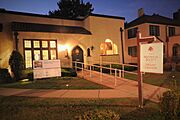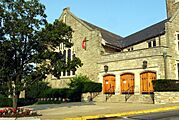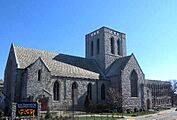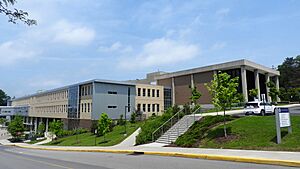Mt. Lebanon, Pennsylvania facts for kids
Quick facts for kids
Mt. Lebanon, Pennsylvania
|
|
|---|---|
|
Home rule municipality
|
|
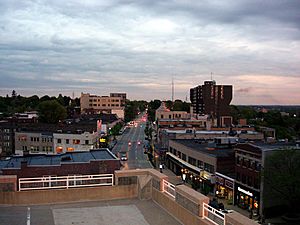
Uptown Mt. Lebanon along Washington Road (Rt. 19 Truck)
|
|
| Motto(s):
"A Community with Character"
|
|
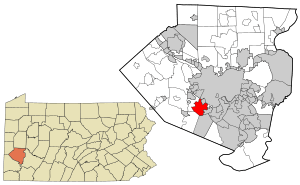
Location in Allegheny County and in Pennsylvania
|
|
| Country | United States |
| State | Pennsylvania |
| County | Allegheny |
| Government | |
| • Body | Commission |
| Area | |
| • Total | 6.08 sq mi (15.75 km2) |
| • Land | 6.08 sq mi (15.74 km2) |
| • Water | 0.00 sq mi (0.01 km2) |
| Population
(2020)
|
|
| • Total | 34,075 |
| • Density | 5,604.44/sq mi (2,163.49/km2) |
| Time zone | UTC-5 (EST) |
| • Summer (DST) | UTC-4 (EDT) |
| ZIP code |
15228
|
| FIPS code | 42-003-51696 |
| Website | www.MtLebanon.org |
|
Mt. Lebanon Historic District
|
|
| NRHP reference No. | 14000813 |
| Added to NRHP | September 30, 2014 |
Mt. Lebanon is a special kind of town called a home rule municipality in Allegheny County, Pennsylvania, United States. It's a suburb of Pittsburgh. This means it's a community near a big city. In 2020, about 34,075 people lived there.
Mt. Lebanon started as a farming area in 1912. Over time, it grew into a "streetcar suburb." This happened when streetcar lines were built in 1901. These lines made it easy for people to travel to Downtown Pittsburgh for work. Later, the Liberty Tunnel opened in 1924. This made it even easier to get to Pittsburgh by car. In 1975, Mt. Lebanon became one of the first places in Pennsylvania to adopt a home rule charter. This gave the town more control over its own local laws.
Contents
History of Mt. Lebanon
Early Settlers and Naming
The first European settlers arrived in the Mt. Lebanon area around 1773 and 1774. They bought land from the family of William Penn, who founded Pennsylvania. Other pioneers also bought land from the state government.
In 1912, the area officially became "Mount Lebanon Township." Before that, it was part of Scott Township. The name "Mount Lebanon" comes from a region in the Middle East. It was not named after two specific cedar trees planted there in 1850. Instead, the area reminded people of the landscape of Mount Lebanon. A post office near these trees was named "Mount Lebanon" in the 1880s.
Growth and Transportation
Mt. Lebanon was mostly a farming community for many years. But everything changed with the arrival of streetcar lines. The first line to Pittsburgh opened on July 1, 1901. A second line followed in 1924. These streetcars allowed people to live in Mt. Lebanon and commute to Downtown Pittsburgh every day. This is how it became a "streetcar suburb."
The first real estate developments, where new homes were built, started in November 1901. The opening of the Liberty Tubes in 1924 also made it simple to drive to Pittsburgh. Because of these changes, Mt. Lebanon's population grew very quickly. Between 1920 and 1930, the number of people living there jumped from 2,258 to 13,403.
Today, Pittsburgh's public transportation system, called Pittsburgh Regional Transit (PRT), has a light rail system. The Red Line runs under Uptown Mt. Lebanon through the Mt. Lebanon Tunnel. Mt. Lebanon has its own station, Mt. Lebanon Station, in the Uptown area.
Local Government and Modern Era
In 1928, Mount Lebanon was the first "First Class township" in Pennsylvania to use a council–manager system. This means that an appointed manager helps run the town's daily operations.
In 1971, famous boxer Muhammad Ali tried to buy a home in the Virginia Manor area. He faced difficulties in purchasing the property. Some people said it was because of the attention and crowds his presence might bring.
On May 21, 1974, the people of Mt. Lebanon voted to approve a home rule charter. This charter took effect on January 1, 1975. This made Mt. Lebanon one of the first towns in Pennsylvania to have a home rule charter. With this change, the official name became "Mt. Lebanon, Pennsylvania." The word "Mount" is now shortened to "Mt." in all government papers.
Geography and Location
Mt. Lebanon is located at 40°22′30″N 80°3′0″W / 40.37500°N 80.05000°W. It covers about 6.06 square miles (15.75 square kilometers) of land.
Surrounding Communities
Mt. Lebanon is a wealthy suburb located about 7 miles (11 km) south of Pittsburgh's downtown. It shares small borders with Pittsburgh neighborhoods like Brookline and Banksville. Other nearby towns include Dormont to the northeast and Scott Township to the west. To the south, you'll find Upper St. Clair and Bethel Park. To the east are Castle Shannon and Baldwin Township.
Commercial Districts
Uptown Mt. Lebanon is the main shopping and business area. Its main street is Washington Road (U.S. Rt. 19 Truck). This road continues into Pittsburgh and beyond. Uptown Mt. Lebanon is a busy area with many coffee shops, art galleries, pizza places, and clothing stores. There are also other business areas along the borders with Upper St. Clair and Castle Shannon.
Communities within Mt. Lebanon
Mt. Lebanon has several smaller neighborhoods within it. These include Beverly Heights, Cedarhurst Manor, Hoodridge Hilands, Mission Hills, Sunset Hills, Twin Hills, and Woodridge.
Virginia Manor is a well-known neighborhood with streets that follow the natural shape of the land. James H. Duff, who later became governor, helped start Virginia Manor in 1929.
Population and People
| Historical population | |||
|---|---|---|---|
| Census | Pop. | %± | |
| 1920 | 2,258 | — | |
| 1930 | 13,403 | 493.6% | |
| 1940 | 19,571 | 46.0% | |
| 1950 | 26,604 | 35.9% | |
| 1960 | 35,361 | 32.9% | |
| 1970 | 39,157 | 10.7% | |
| 1980 | 34,414 | −12.1% | |
| 1990 | 33,362 | −3.1% | |
| 2000 | 33,017 | −1.0% | |
| 2010 | 33,137 | 0.4% | |
| 2020 | 34,075 | 2.8% | |
| 2022 (est.) | 33,218 | 0.2% | |
| Sources: | |||
As of the 2020 census, Mt. Lebanon had a population of 34,075 people. In 2000, there were 33,017 people living in the township. The average age of residents in 2000 was 42 years old. About 24.8% of the population was under 18 years old.
Arts and Culture
|
Mt. Lebanon Historic District
|
|
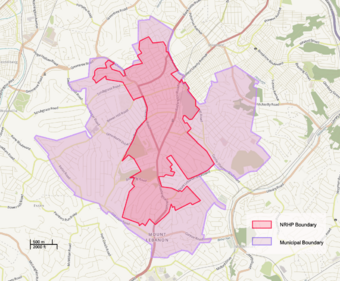 |
|
| Area | 1,306.0 acres (528.5 ha) |
|---|---|
| Built | 1874–1945 |
| NRHP reference No. | 14000813 |
| Added to NRHP | September 30, 2014 |
A large part of Mt. Lebanon is known as the Mt. Lebanon Historic District. This district is listed on the National Register of Historic Places. It includes many old buildings, mostly homes, built between 1874 and 1945. This area shows how the town changed from a farming area to a busy suburb. This change was first made possible by trolleys and later by cars.
Parks and Recreation
Mt. Lebanon offers many fun activities for its residents. There are 15 parks spread across more than 200 acres (81 hectares) in the community. You can also find an Olympic-sized swimming pool, which is open in the summer. There's also an ice rink and a recreation building near Mt. Lebanon Park.
The town has one of the oldest public golf courses in western Pennsylvania. You can also find several tennis and basketball courts that are open all year. Other places to play include a sand volleyball court, bocce courts, and platform tennis. There are also many picnic spots and over eight playgrounds for kids.
The sports teams from the Mt. Lebanon School District are very important to the community. Their mascot is the Blue Devil.
Education in Mt. Lebanon
The Mt. Lebanon School District has seven elementary schools: Foster, Hoover, Howe, Jefferson, Lincoln, Markham, and Washington. There are two middle schools: Jefferson Middle School and Andrew W. Mellon Middle School. The district has one high school: Mt. Lebanon High School.
The schools in Mt. Lebanon have won many awards, including the National Blue Ribbon School awards. In 2000, Newsweek magazine named the high school one of the Top 500 high schools in the United States. In 2005, the Pittsburgh Business Times ranked it #1 in Western Pennsylvania.
Other schools in Mt. Lebanon include Keystone Oaks High School, which serves nearby communities. Seton-La Salle Catholic High School and St. Bernard school, which are Catholic schools, are also located here.
The Mt. Lebanon Public Library started in 1932. It's mostly funded by the town and county. The library building, which opened in 1997, cost $4.2 million. It can hold 140,000 books and has more than 50 public computers. The building even won an award for its design!
Notable People from Mt. Lebanon
Many interesting people have lived in or are from Mt. Lebanon:
- Kurt Angle, an Olympic gold medalist in freestyle wrestling and a former professional wrestler.
- Shane Black, a screenwriter and director.
- Mark Cuban, a businessman and TV personality.
- Daya, a singer.
- Dave Filoni, a filmmaker and animator known for Star Wars: The Clone Wars.
- Ian Happ, a professional baseball player for the Chicago Cubs.
- Gillian Jacobs, an actress.
- Joe Manganiello, an actor.
- Andrew Mason, who founded Groupon.
- Ming-Na Wen, an actress, who partly grew up and went to high school here.
See also
 In Spanish: Municipio de Mt. Lebanon para niños
In Spanish: Municipio de Mt. Lebanon para niños


